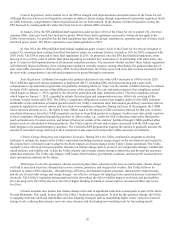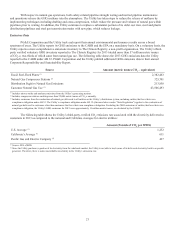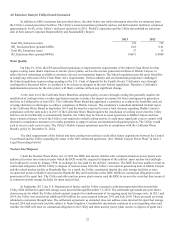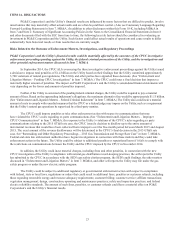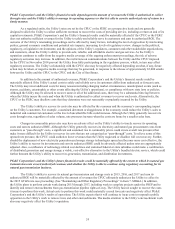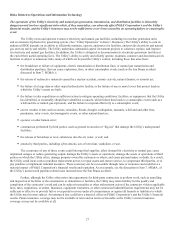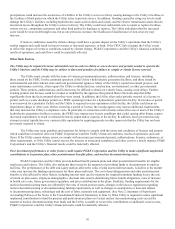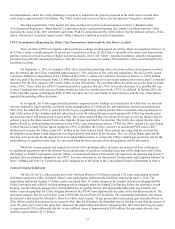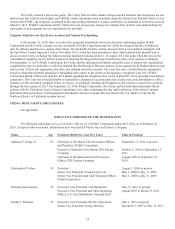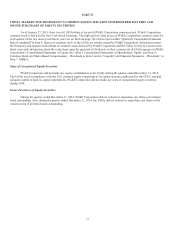PG&E 2014 Annual Report Download - page 37
Download and view the complete annual report
Please find page 37 of the 2014 PG&E annual report below. You can navigate through the pages in the report by either clicking on the pages listed below, or by using the keyword search tool below to find specific information within the annual report.29
At the state level, the California Water Board has adopted a policy on once-through cooling that generally requires the
installation of cooling towers or other significant measures to reduce the impact on marine life from existing power generation
facilities in California by at least 85%. If the California Water Board requires the installation of cooling towers that the Utility
believes are not technically or economically feasible, the Utility may be forced to cease operations at Diablo Canyon and may
incur a material charge. Even if the Utility is not required to install cooling towers, it could incur significant costs to comply with
alternative compliances measures or to make payments to support various environmental mitigation projects.
The Utility also has an obligation to decommission its electricity generation facilities, including its nuclear facilities, as
well as gas transmission system assets, at the end of their useful lives. (See Note 2: Summary of Significant Accounting Policies –
Asset Retirement Obligations of the Notes to the Consolidated Financial Statement in Item 8.) The CPUC authorizes the Utility to
recover its estimated costs to decommission its nuclear facilities through nuclear decommissioning charges that are collected from
customers and held in nuclear decommissioning trusts to be used for the eventual decommissioning of each nuclear unit. If the
Utility’s actual decommissioning costs, including the amounts held in the nuclear decommissioning trusts, exceed estimated costs,
PG&E Corporation’s and the Utility’s financial results could be materially affected.
Risks Related to Environmental Factors
The Utility’s operations are subject to extensive environmental laws and changes in or liabilities under these laws could
adversely affect PG&E Corporation’s and the Utility’s financial results.
The Utility’s operations are subject to extensive federal, state, and local environmental laws, regulations, orders, relating
to air quality, water quality and usage, remediation of hazardous wastes, and the protection and conservation of natural resources
and wildlife. The Utility incurs significant capital, operating, and other costs associated with compliance with these environmental
statutes, rules, and regulations. The Utility has been, and may be, required to pay for environmental remediation costs at sites
where it is identified as a potentially responsible party under federal and state environmental laws. Although the Utility has
recorded liabilities for known environmental obligations, these costs can be difficult to estimate due to uncertainties about the
extent of contamination, remediation alternatives, the applicable remediation levels, and the financial ability of other potentially
responsible parties. (See Note 14 to the Notes to the Consolidated Financial Statements in Item 8 for more information.)
Environmental remediation costs could increase in the future as a result of new legislation, the current trend toward more
stringent standards, and stricter and more expansive application of existing environmental regulations. Failure to comply with these
laws and regulations, or failure to comply with the terms of licenses or permits issued by environmental or regulatory agencies,
could expose the Utility to claims by third parties or the imposition of civil or criminal fines or other sanctions.
The CPUC has authorized the Utility to recover its environmental remediation costs for certain sites through various
ratemaking mechanisms. One of these mechanisms allows the Utility rate recovery for 90% of its hazardous substance remediation
costs for certain approved sites without a reasonableness review. The CPUC may discontinue or change these ratemaking
mechanisms in the future or the Utility may incur environmental costs that exceed amounts the CPUC has authorized the Utility to
recover in rates.
Some of the Utility’s environmental costs, such as the remediation costs associated with the Hinkley natural gas
compressor site, are not recoverable through rates or insurance. (See “Environmental Regulation” in Item 1.) The Utility’s costs to
remediate groundwater contamination near the Hinkley natural gas compressor site and to abate the effects of the contamination
have had, and may continue to have, a material effect on PG&E Corporation’s and the Utility’s financial results. Their financial
results also can be materially affected by changes in estimated costs and by the extent to which actual remediation costs differ from
recorded liabilities.
The Utility’s future operations may be affected by climate change that may have a material impact on PG&E Corporation’s and
the Utility’s financial condition, results of operations, and cash flows.
The Utility has been studying the potential effects of climate change (increased temperatures, reduced precipitation,
rising sea levels) on the Utility’s operations and is developing contingency plans to adapt to those events and conditions that the
Utility believes are most significant. Scientists project that climate change will increase electricity demand due to more extreme,
persistent and hot weather. Increasing temperatures and lower levels of precipitation in the Utility’s service territory would reduce
snowpack in the Sierra Mountains. If the levels of snowpack were reduced, the Utility’s hydroelectric generation would decrease
and the Utility would need to acquire additional generation from other sources at a greater cost. Should the Utility increase
reliance on conventional generation resources to replace hydroelectric generation and to meet increased customer demand, it may
become more costly for the Utility to comply with GHG emissions limits. In addition, increasing temperatures and lower levels of



